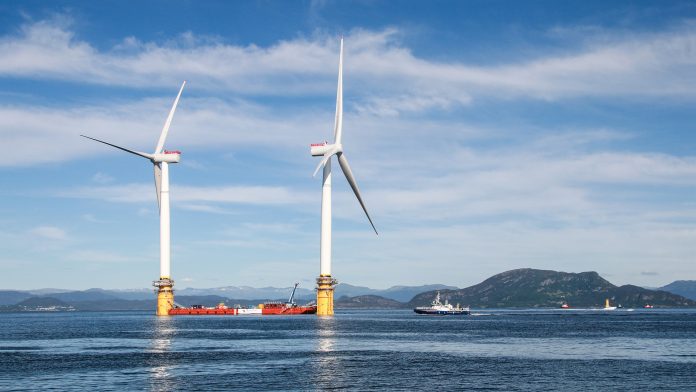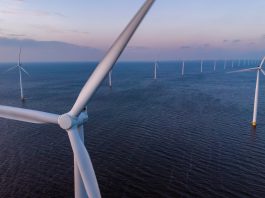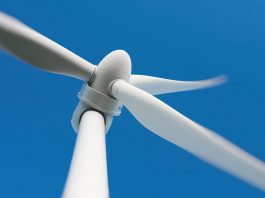Floating offshore wind farms offer a great prospect to fully decarbonise both Europe and the world, and the STEP4WIND H2020 Innovative Training Network will help to advance it.
Floating offshore wind energy has been identified as a key enabler to make Europe climate neutral by 2050. Today, floating offshore wind energy is still in a pre-commercial stage of development. However, its growth is forecasted to be significant in the coming decades, with predicted installed capacities reaching up to 30GW by 2030 and 150GW by 2050 worldwide.1
With several floating offshore wind turbine prototypes now operating and a number of small pilot farms currently developed being in European waters, floating wind energy has already reached high technology readiness levels of system demonstration over the full range of expected conditions (TRL 8-9). However, key challenges stand in the way of increasing its Commercial Readiness Index (CRI) from ‘Commercial Trial’ to ‘Commercial Scale Up’. The commercial development of floating offshore wind farms, in addition to bottom-mounted wind turbines, will widen the market and add to the investment and volume needed to meet cost-reduction goals.
The STEP4WIND programme contributes to this by delivering a suite of technological advances and guidelines that will increase the CRI of floating offshore wind farms whilst providing a clear roadmap to commercial exploitation. This European Industrial Doctorate programme will deliver 10 doctoral degrees, in joint supervision between the public and private sectors, hence matching skill developments with industry needs. It also includes a dedicated training programme jointly organised by universities and industries. The approach adopted in this project is further explained below.
Technology
As opposed to bottom-fixed turbines which are directly mounted on the seabed, floating wind turbines are placed on a floating support structure that is moored to the seabed. This enables the installation of wind turbines in much deeper waters, thereby unlocking a vast amount of the exploitable wind energy generation in Europe and worldwide. For example, France, Portugal, and Norway rely on the use of floating wind turbines to enter the offshore wind industry. Floating offshore wind turbines also open up the opportunity to harness wind energy at much higher wind speeds. As an example, the first floating offshore wind farm, Hywind Scotland, is currently producing electricity at record-breaking capacity factors.2
Many concepts of floating offshore wind turbines are currently under development. Most of them differ in the type of floating support structure used. There are four broad categories of floaters being developed:
- Spar-buoy;
- Semi-submersible;
- Barge; and
- Tension-leg platform.
The choice of concept depends on many factors, such as the environmental and site conditions. Ultimately, the ability for industrialisation and scaling up will be crucial for achieving the large deployment goals.
Techno-economic challenges
Despite the huge potential of floating offshore wind turbines, their development presents new technological and economical challenges. Platform motions may cause the rotor blades to interact with their own wake and operate under different flow regimes that are highly unsteady. Vice-versa, the rotor thrust influences the dynamics of the whole floating structure. Due to these coupled dynamics, a controller designed for fixed turbines would destabilise the system, making floating offshore wind turbines unsafe to operate. Thus, innovations are required on the turbine design and its controller, especially for operation under highly unsteady conditions. These innovations could be instrumental in driving down the wind turbine cost, which currently amounts to a quarter of the total cost of a floating turbine.
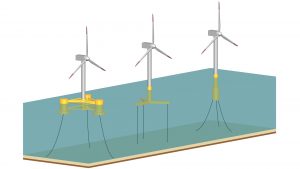
The increased wind turbine size also poses challenges in terms of the production of very long blades, which require novel materials and manufacturing processes. In terms of costs, another large contributor is the ensemble floater-moorings, which represent a third of the total cost. This is because the design of these components is too conservative and not properly scaled with the rating of the wind turbine.
Design conservatism and moorings’ lifetime can be changed by improving the design model chain, including the modelling of dynamic moorings and anchoring systems. Another significant cost contributor is related to the electrical aspects. Cable-related failures account for up to 80% of offshore wind project insurance claims. Thus, dynamic power cables and the connection of inter-array cables in floating farms still need to be optimised. Integrating energy storage in floating offshore wind farms is also key to ensuring the reliability of the energy supplied.
Finally, the logistics also needs attention, with the development of new installation methods for scaling up the commissioning process. Floating-specific operation and maintenance (O&M) strategies are also needed to avoid unnecessary high costs in remote deepwater sites.
Approach and expected outcomes of STEP4WIND
STEP4WIND tackles these challenges through 10 PhD (ESR) projects spread across the supply chain. The individual projects range from the design of a single wind turbine with high-fidelity models for the hydro- (ESR1) and aero- (ESR2) dynamics, to the development of Machine-Learning techniques (ESR3) that bridge high-fidelity data and engineering models, as well as system engineering approaches (ESR4).
Dedicated projects also focus on testing and validation methodologies for the whole turbine (ESR5) as well as the dynamic cables (ESR7), whilst also tackling manufacturing (ESR6) and installation (ESR8) methods. Finally, operation and maintenance are being developed (ESR9) and combination of floating turbines with green hydrogen production is also investigated (ESR10).
Importantly, the innovations developed in each project are integrated in a common multi-disciplinary design analysis and optimisation framework (MDAO) to assess their impact on the overall levelised cost of energy whist accounting for the whole supply chain. This is crucial for the successful industrialisation of floating offshore wind farms.
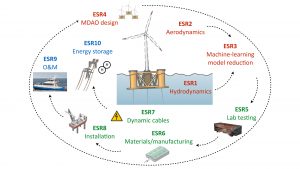
Through these projects, STEP4WIND is expected to identify the main drivers for cost reductions in floating offshore wind farms and perform integrated design optimisation on the whole innovation chain. It will also develop floating-specific O&M strategies, energy storage, electrical infrastructures, and logistics, as well as test and validation methodologies for floating turbines. Finally, it will improve the engineering design tools through a better understanding of the unsteady effects on the dynamics of these turbines. Importantly, it will help to close the skills gap by transferring a wide range of scientific and market-oriented skills to the early-stage researchers, whilst also providing them a good understanding of the entire innovation chain, from product development to marketability.
Future opportunities
As floating offshore wind farms can, in principle, be installed anywhere at sea, they open up new possibilities for re-thinking how offshore wind farms are designed and operated across the supply chain, as well as how they can be used for other purposes than solely electricity production. For example, floating offshore wind farms could play a significant role in a hydrogen-based economy, where large volumes of hydrogen will be needed for use in a number of different sectors. This could help to truly decarbonise the world. But before we get there, we need to tackle the new fundamental and industrial challenges in a more holistic way.
Acknowledgment
The author acknowledges support from the European Commission under the H2020 ITN project STEP4WIND (grant agreement no. 860737) funded by the European Union’s Horizon 2020 research and innovation programme under the Marie Sklodowska-Curie scheme.
References
- IRENA (2019), Future of wind: Deployment, investment, technology, grid integration and socio-economic aspects (A global Energy transformation paper), International Renewable Energy Agency (IEA), Abu Dhabi
- BBC News, ‘Floating wind farm records UK’s top results for potential output again’, 23 March 2021
Please note, this article will also appear in the seventh edition of our quarterly publication.

